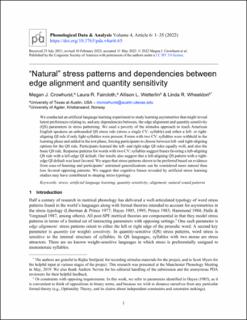“Natural” stress patterns and dependencies between edge alignment and quantity sensitivity
Peer reviewed, Journal article
Published version

View/
Date
2022Metadata
Show full item recordCollections
Original version
Crowhurst, M. J., Faircloth, L. R., Wetterlin, A. L., Wheeldon, L. R. (2022). “Natural” stress patterns and dependencies between edge alignment and quantity sensitivity. Phonological Data & Analysis (PDA), 4 (6), 1-35. https://doi.org/10.3765/pda.v4art6.65Abstract
We conducted an artificial language learning experiment to study learning asymmetries that might reveal latent preferences relating to, and any dependencies between, the edge alignment and quantity sensitivity (QS) parameters in stress patterning. We used a poverty of the stimulus approach to teach American English speakers an unbounded QS stress rule (stress a single CV: syllable) and either a left- or right-aligning QI rule if only light syllables were present. Forms with two CV: syllables were withheld in the learning phase and added in the test phase, forcing participants to choose between left- and right-aligning options for the QS rule. Participants learned the left- and right-edge QI rules equally well, and also the basic QS rule. Response patterns for words with two CV: syllables suggest biases favoring a left-aligning QS rule with a left-edge QI default. Our results also suggest that a left-aligning QS pattern with a rightedge QI default was least favored. We argue that stress patterns shown to be preferred based on evidence from ease-of-learning and participants’ untrained generalizations can be considered more natural than less favored opposing patterns. We suggest that cognitive biases revealed by artificial stress learning studies may have contributed to shaping stress typology.
